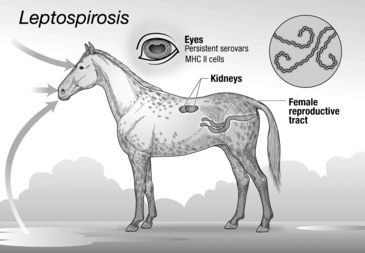CHAPTER 33 Leptospirosis
Leptospirosis is caused by highly invasive, spiral bacteria of the genus Leptospira. The infectious agent is capable of infecting both humans and animals. Less is known about leptospirosis in horses than in any of the common domestic animals except cats. On the basis of DNA-DNA reassociation studies, genus Leptospira is classified into 13 named species and 4 genomospecies, several of which contain both pathogenic and nonpathogenic serovars. Serovars, which are based on the older phenotype classification, are sometimes classified as causing host-adapted infection or incidental host infection. Host-adapted strains seldom cause clinical disease in their maintenance host, infection and shedding are prolonged, and the serologic response following infection is relatively low. Conversely, incidental host serovars are more likely to cause clinical disease in a nonmaintenance host, a marked serologic response occurs following infection, and there is only a brief period of shedding.
CLINICAL SYNDROMES
Pathogenic Leptospira infections in the horse appear to have organ trophism for the kidney, eye, or female reproductive tract (Figure 33-1). Infection may result in placentitis and abortion, acute renal failure or hematuria, and, importantly, uveitis.
Acute Renal Failure
Occasionally L. pomona causes fever and acute renal failure in horses. The kidneys are swollen as a result of tubulointerstitial nephritis, and urinalysis may reveal pyuria without visible bacteria. On rare occasions, multiple horses may be affected with fever and acute renal failure following Leptospira infection.
Stay updated, free articles. Join our Telegram channel

Full access? Get Clinical Tree



